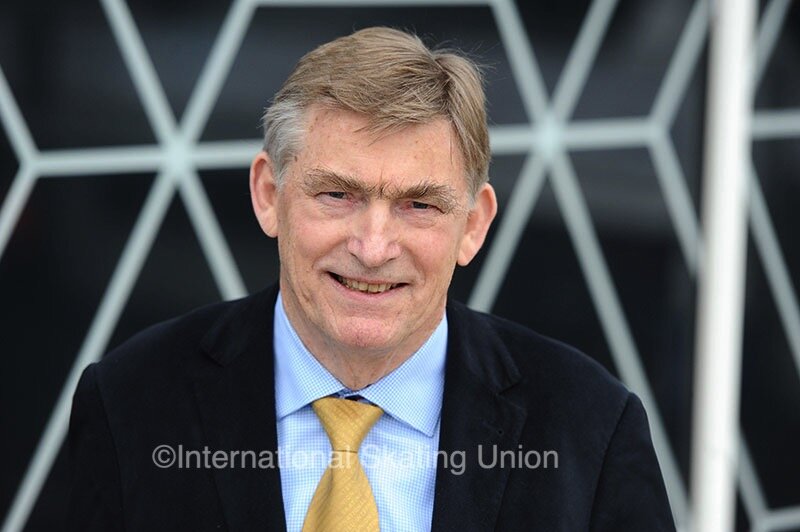

The Covid-19 pandemic created unprecedented challenges for the International Skating Union (ISU) and the nations that organized competitions this season. Though many events had to be canceled, four stops of the six Grand Prix Series, the World Championships and the World Team Trophy — as well as some smaller international competitions and national championships — did take place.
Of all the figure skating competitions that were held, the 2021 World Championships was by far the most complex to organize given the number of people involved. But ISU President Jan Dijkema considers the Championships were a “great success.” All the hard work and planning behind the scenes paid off, not only for figure skating but also the speed skating and short track competitions, which took place in the Netherlands, with the safety of all participants the top priority for the ISU and the respective organizing committees.
“We saw high-level and breath-taking performances from the skaters, and the true spirit of sportsmanship in this difficult season,” he said of the World Championships. “Although we really missed the cheering spectators on site, we provided millions of fans around the globe with a spectacular competition. This memorable world-class event was a great promotion for our beloved sport. From the beginning, we consistently applied our policy that the health and safety of all participants at ISU events was the number one priority. Mindful of the concern for health and safety precautions related to COVID-19, and also the need to provide skaters and fans with international competitions, we did our utmost to stage events safely.”
So how was all this accomplished?
Throughout April and May of 2020, when the first wave of the pandemic hit most of the world and many countries went into lockdown, the ISU moved quickly and formed two working groups to assess the situation and to find ways to organize events under the extreme circumstances. The concepts developed were based on the rules that were in place globally: Social distancing, masks, hygienic measures, continuous testing and the creation of the bubble concept, which precluded anyone from moving outside the restricted areas with no direct contact or physical interaction with anyone outside the bubble permitted.
“The health regulations at the 2021 World Championships were prepared in close cooperation with the ISU Medical Commission, the organizing committee, a medical team and the Swedish health authorities,” Dijkema explained. “Strict and comprehensive protocols and measures of social distancing, hand washing, masks and daily health and temperature checks were implemented, along with a rigorous testing regime. Everyone within the competition bubble had multiple PCR tests.”
Indeed, for Worlds and the World Team Trophy, all participants needed to produce a negative PCR test before departing for Sweden or Japan, and those tests could not be more than 48 hours old. All participants were tested again upon arrival and isolated in hotel rooms until they received their test results.
Basically, everyone was tested every second day in Stockholm, where more than 3000 PCR or antigen tests were performed. All participants had to submit a health check form every morning, and a temperature check was conducted at the entrance to the arena.
“It took a huge amount of preparation and planning,” said Dijkema. “Everyone involved with the event was fully dedicated to creating the best and safest possible environment. As the situation changed and new government and travel restrictions were announced, it was imperative to remain flexible and to adapt to the changing rules. This was a big challenge but one the organizing committee and the ISU were not afraid of.”
However, Dijkema made it clear that, if it had been deemed necessary a last-minute cancellation of this competition remained. “The decision to hold ISU events was continuously subject to the unpredictable development of the pandemic and the rules and measures of the national authorities. We also conducted surveys among the ISU members in order to obtain an overview of the potential participation,” he explained.
“The COVID-19 crisis has had a huge impact on society and the consequences have also been felt strongly in the ice skating community. Skaters want to skate and fans want to enjoy their performances. Therefore, the ISU gave its support to the greatest extent possible to hold events in a safe way, and also in terms of financial support, which was another aspect in the decision-making process. We invested a lot of resources, but it is our purpose to promote the sport and organize events for skaters and fans.”
The ISU adapted the bubble concept to the fit each of the three sports — figure skating, speed skating and short track — and the different venues where these competitions took place. “Each sport had its own requirements and setup and, consequently, different ways for conducting the event,” Dijkema explained. “The speed skating hub was tailor-made for its needs and wants, as was the figure skating bubble for the World Championships. The goal for all ISU events this season was to host them in a way to ensure the safety of all participants; the details, however, were specific to each situation and sport. Each ice rink and hotel was different and required different setups.
“The daily routine and the needs and wants of figure skating differ from other sports. Therefore, those had to be taken into consideration first when setting up the competition bubble with the goal to make the stay of the guests as convenient and comfortable as possible, while allowing them to focus on the sport and feel safe. That included the setup of the organizing committee and the volunteers, and also activities such as on-ice and off-ice practices, dining, recreational activities, etc.
“The Championships in Stockholm did not allow any physical contact with media representatives other than those who were part of the competition bubble (i.e. a few TV camera operators from the host broadcaster). All media operations from television right holders to journalists were done virtually, as the facility did not allow any physical crossing of paths of non-bubbled and bubbled event participants. This was avoided to keep the bubble closed. As I said, every event was unique and thus, only a basic concept could be established for all events, but the details needed to be tailor made for the respective events.”
The concepts applied in other sports and at other events — such as Skate America, which was the first in figure skating to use a bubble concept — were incorporated to create the set up that was in place in Stockholm, and the similar one in place at the World Team Trophy. No positive test results were detected at any of the speed skating and short track events, nor at the World Team Trophy.
However, three positive test results were detected at the World Championships. The ISU did not publish any names, but the Belarussian team leader, Oleg Vasiliev, confirmed to international media that one case concerned the Belarussian singles skater Viktoriia Safonova. The second case was, according to unconfirmed reports, a judge from Ukraine.
Those two positive tests were detected upon arrival in Stockholm, both were isolated and neither party interacted with anyone within the bubble. The third test, however, happened during the week with Simon Proulx-Sénécal, a Canadian who competes in ice dance for Armenia. He and his partner Tina Garabedian later published a video wherein they stated that his test result was a false positive and they were upset about not being able to compete.
However, what could have been done differently? When the test result came back as positive, the ISU had no choice but to follow its own protocol. Dijkema believes that the cases were handled correctly and that the system worked well. “The protocols, as set out per the ISU health regulations and the rules of the Swedish authorities, were followed and clearly worked. For example, close contact cases were quickly identified, investigated and tested. We will continue to follow our protocols and the rules of national authorities also in the future should there still be a bubble concept.”
A small vocal group of critics — fans and some fringe media — predicted doom, claiming that the World Championships would turn into a huge Covid-19 super spreader. Clearly, they were wrong — although they would never admit that. “The health and safety of all participants at the World Championships was the number one priority for the ISU and the organizing committee,” Dijkema said in response to the criticism. ”With the full support and involvement of the Swedish government health authorities, the ISU and the organizing committee medical experts, it was possible to hold the Championships not only successfully but also safely. Everyone felt safe in the bubble which created a sense of security, but it was important to remain focused with the task at hand, which was to hold a safe Championships.”
As president of the ISU, Dijkema carried a lot of responsibility on his shoulders over the past year, but he has faced many challenges in his decades of experience as a speed skating/short track official, and was well-equipped to handle the pressure. “I have faced a number of challenges during my career. For example, I remember an event in Norway where the ice resurfacers and systems broke down and the multi-day competition had to be held in one day,” he recalled. This was a critical situation where everyone had to come together to save the event. I was really aware of that (pressure) and following the protocols strictly was key. You must be very alert all the time and lead by example.
“There have been other situations where quick and difficult decisions had to be made. However, it was really an unprecedented challenge to organize premium ISU events during the COVID-19 pandemic. The logistics and planning of such events were very complex, and we would not have been able to pull it off without the organizing committees, sponsors, TV partners and stakeholders.”
Obviously, the pandemic had — and still has — a serious negative impact on sporting events and life in general, but out of all this have come some positives. The crisis encouraged the development of online activities such as seminars, the ISU E-Learning platform and virtual competitions.
For example, the virtual mixed zone for journalists was a useful tool that will probably be incorporated into events going forward Dijkema said. Consequently, the media had no physical access to the athletes and remote access had to be put in place. “This was a challenge for everyone involved as new technology and procedures had to be introduced, but in the end the feedback from the media was overwhelmingly positive. The overall experience was positive. The ISU wishes to make its sports as accessible as possible to the media. I believe that remote access provides that opportunity. Therefore, we are evaluating how remote access could play a role at future ISU events and Championships.”
If necessary, the ISU will continue to use the bubble concept next season, but Dijkema is looking forward to “normal” competitions taking place, as is everyone else. “Let us hope that the situation will further improve and that we can have events again with many colorful and cheering spectators in the stadium,” he said.
Dijkema wished to express his thanks to everyone involved, including the athletes and national federations, noting “it was a team effort,” and that he is pleased the 2020-2021 season was concluded successfully.
RELATED CONTENT:
2020-2021 COMPETITION CALENDAR



